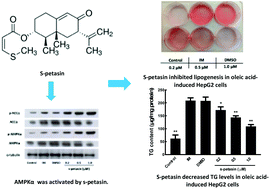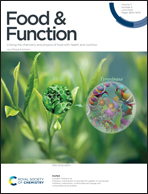S-petasin inhibits lipid accumulation in oleic acid-induced HepG2 cells through activation of the AMPK signaling pathway
Abstract
Nonalcoholic fatty liver disease (NAFLD) has become one of the most common medical problems. Inhibition of lipogenesis and promotion of lipolysis are two ways to prevent NAFLD. In this study, oleic acid-induced HepG2 cells are used as a NAFLD cell model to test whether s-petasin exerts inhibition of lipogenesis and promotion of the lipolysis effect. The results showed that s-petasin significantly inhibited the lipid level in oleic acid-induced HepG2 cells. Moreover, results showed that the triacylglycerol level was reduced by s-petasin in oleic acid-induced HepG2 cells. Western blot assay revealed that s-petasin stimulated phosphorylation of AMPKα and ACCα. The results also demonstrated that s-petasin can inhibit lipogenesis and enhance triacylglycerol turnover by down-regulation of FAS and SCD-1 and up-regulation of ATGL and HSL through the AMPK signaling-dependent regulation of transcriptional factors, FKHR and SREBP-1. This in vitro study indicates that s-petasin has potential as a candidate compound for NAFLD therapy.



 Please wait while we load your content...
Please wait while we load your content...